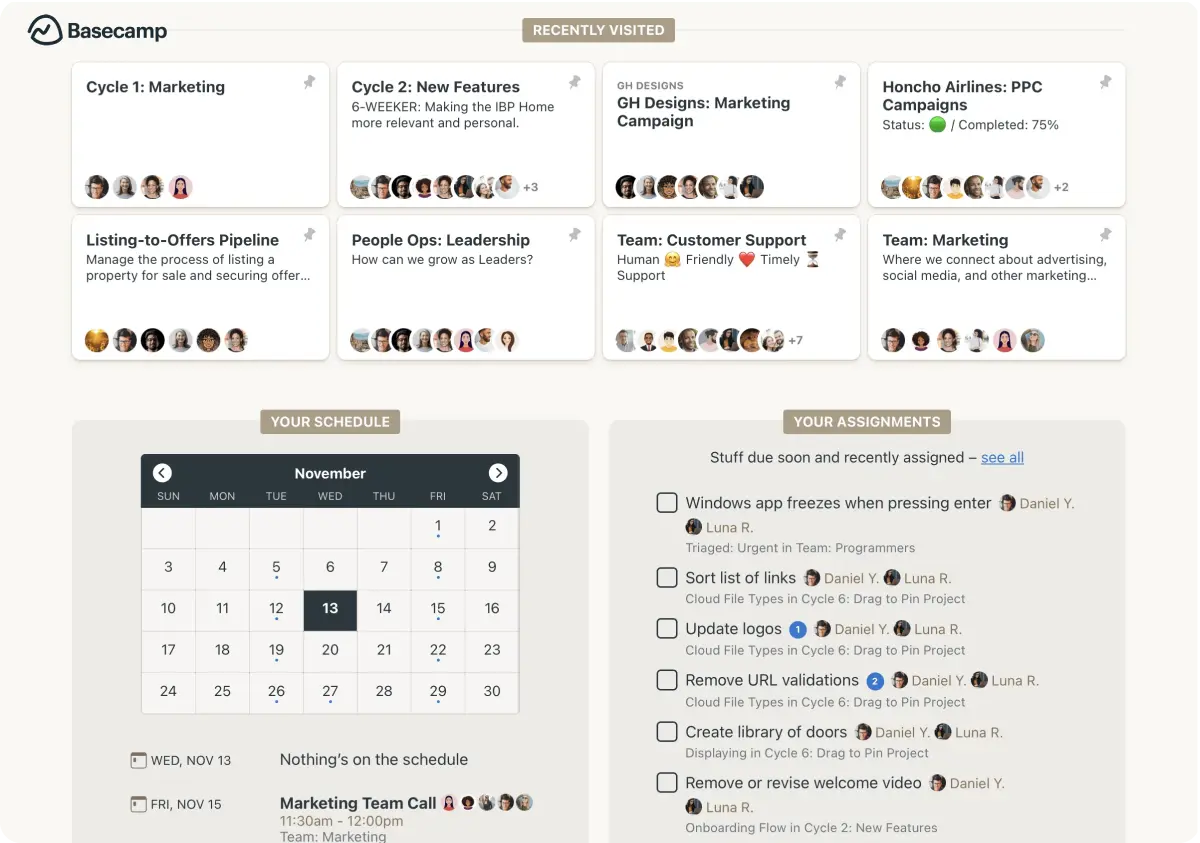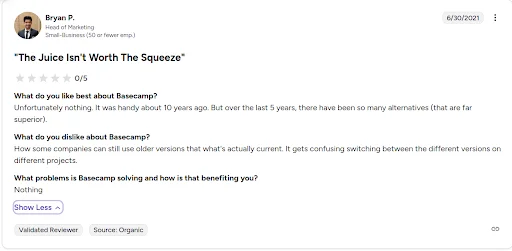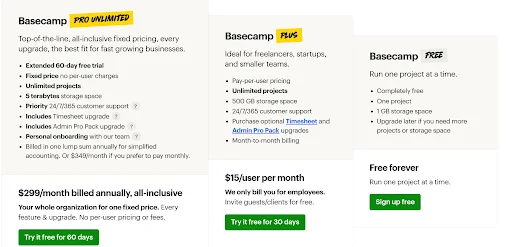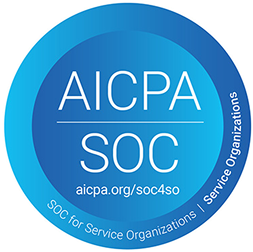Table of Contents
Overview
Basecamp is a great tool for managing multiple projects. It is easy to use and keeps work organized.
It helps teams work together without complicated features.
Small businesses and creative agencies like it because it’s quick to learn.
Key strengths:
- Clean design
- Good for team communication
- Works well for client projects
It’s best for teams who want to focus on work, not on figuring out complex software.
What Users like About Basecamp
✅ Easy to learn and use
✅ Minimal learning curve
✅ Reliable performance
✅ Reliable and stable platform
What Users Dislike About Basecamp
❌ Limited advanced features
❌ No built-in time tracking
❌ Can be expensive for large teams
❌ Missing reporting tools
What are the Most Useful Basecamp Features?
Basecamp comes with a range of tools designed to keep projects organized and teams on the same page.

1. To-do Lists
Simple task creation and assignment
➤ Create tasks and assign them to team members easily
➤ Add due dates and notes to keep everyone informed
➤ Check off completed tasks to show progress
2. Message Boards
Team discussions and announcements
➤ Start topic-based discussions for different projects
➤ Post updates and announcements for the whole team
➤ Keep conversations organized by project or topic
3. Campfire Chat
Real-time team messaging
➤ Chat with team members instantly like texting
➤ Share quick updates and ask questions fast
➤ See who’s online and available to talk
4. Documents & Files
Share and collaborate on files
➤ Organize and upload files in one central location
➤ Work together on documents with version control
➤ Share files with clients and external partners safely
5. Schedule
Team calendar for deadlines and events
➤ Add project milestones and important dates
➤ See everyone’s deadlines in one shared calendar
➤ Get reminders before important dates arrive
6. Client Access
Let clients see project updates
➤ Give clients limited access to see their project progress
➤ Share updates without giving full team access
➤ Keep clients informed without constant email updates
Know About User Experience
Check what users are saying in Basecamp reviews. Explore real experiences before making your choice.

A Quick Look at Basecamp Pricing Plans
Basecamp offers different plans so teams can choose the one that fits their size, needs, and budget.
Here are its different pricing plans.

- The free plan is useful for trying Basecamp but is limited to just one project
- The $15/user/month plan allows unlimited projects, but costs can rise quickly as your team grows
- The Pro Unlimited plan offers a flat rate for unlimited projects, but the monthly price can be high for smaller teams
- Pricing may feel less flexible for teams that only need a few key features
Choosing the right plan depends on your team size, budget, and how many features you really need.
What’s Missing in Basecamp?
Basecamp has no time tracking, employee monitoring, or productivity analytics.
Managers cannot see how team members spend their work hours or track individual performance.
There’s no automatic activity monitoring or screenshot capture for remote work accountability.
Workstatus as Better Basecamp Alternative:

Offers project management like Basecamp
✔️Adds automatic time tracking without manual input
✔️Takes regular screenshots for remote work monitoring
✔️Provides detailed productivity analytics and reports
✔️Shows real-time activity levels for each team member
✔️Costs much less than Basecamp’s per-user pricing
✔️Includes GPS tracking for on-site and field teams
✔️Allows custom roles and permissions for better control
✔️Sends smart alerts and notifications to avoid overload
✔️Supports invoicing and payroll directly from tracked hours

💡 Starting at just $2.4 per user/month, Workstatus costs significantly less than Basecamp’s $15 per user monthly fee. If you want simple project management plus team productivity insights, Workstatus offers better value and more useful features.
How Do Users Rate Basecamp on Review Sites?
⭐ G2 Rating: 4.5/5
⭐ Capterra Rating: 5/5
⭐ Trustpilot Rating: 3.8/5
Our Final Verdict
Pick Basecamp if you want simple project management without extra complexity.
It’s good for agencies, small teams or anyone who prefers easy tools and doesn’t need detailed analytics.
Basecamp may not be enough, if you also need to
- Track time
- Check productivity score
- Manage remote teams
Workstatus is a better choice if you want to:
✅ See how long projects take
✅ Track remote team productivity
✅ Get automatic time reports
✅ View real-time activity
✅ Stay on budget and schedule
Basecamp is best for basic organization, while Workstatus helps manage both projects and team performance.
Choose what fits your team best.
FAQs
Does Basecamp provide time tracking for tasks?
No, Basecamp focuses on team communication and task organization, but it lacks automatic time tracking. Workstatus tracks time automatically and shows exactly how work is spent.
Can I see productivity insights in Basecamp?
Basecamp does not offer detailed productivity reports. Workstatus provides real-time activity insights and work patterns for better team management.
Is Basecamp suitable for remote team monitoring?
While Basecamp allows collaboration, it doesn’t give managers visibility into hours worked or task efficiency. Workstatus ensures remote teams are accountable with real-time monitoring.
Does Basecamp track workload balance?
No, workload tracking is limited. Workstatus highlights overworked team members and balances tasks effectively.
Can I link time tracking to billing in Basecamp?
Basecamp doesn’t include automatic time-to-billing features. Workstatus links tracked hours to invoicing for faster and accurate client billing.























